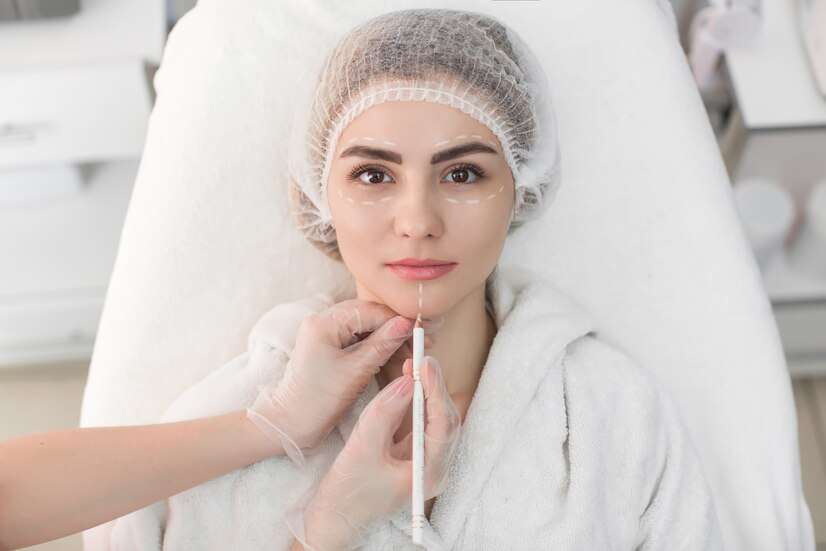Microneedling vs. Chemical Peels: Which is Right for You?

Microneedling vs. Chemical Peels: Which is Right for You?
In the ever-evolving world of skincare, there’s an abundance of treatments promising rejuvenation, radiance, and youthful glow. Among these, two popular contenders stand out: microneedling and chemical peels. Both techniques offer remarkable results in addressing various skin concerns, from acne scars to fine lines and hyperpigmentation. However, the question remains: which one is the optimal choice for your unique skin needs?
In this comprehensive guide, we delve into the intricacies of microneedling and chemical peels, exploring their mechanisms, benefits, and potential considerations. By the end, you’ll be equipped with the knowledge necessary to make an informed decision tailored to your skincare goals.
Let’s embark on this journey to uncover the nuances of these transformative treatments and discover which path leads to your skin’s ultimate radiance.
Understanding Microneedling: The Science Behind Collagen Induction Therapy
Microneedling, also known as collagen induction therapy, harnesses the body’s natural healing process to rejuvenate the skin. During the procedure, a device equipped with fine needles creates controlled micro-injuries on the skin’s surface, stimulating collagen and elastin production.
This increased collagen production helps to improve skin texture, reduce the appearance of fine lines, wrinkles, and scars, and enhance overall skin firmness and elasticity.
Collagen induction therapy is based on the principle that the body responds to these micro-injuries by initiating the skin’s healing process, resulting in a smoother, more youthful complexion over time. Understanding this science behind microneedling is crucial for individuals considering this treatment for their skincare concerns.
Chemical Peels Demystified: How Acidic Solutions Transform Your Skin
Chemical peels are a skincare treatment that involves applying a solution containing various acids to the skin’s surface. These acids work to exfoliate the outermost layer of the skin, removing dead skin cells, unclogging pores, and stimulating cell turnover. The primary acids used in chemical peels include alpha hydroxy acids (AHAs), such as glycolic and lactic acid, beta hydroxy acids (BHAs) like salicylic acid, and trichloroacetic acid (TCA).
Each type of acid has unique properties and penetrates the skin to different depths, targeting specific skin concerns such as acne, hyperpigmentation, fine lines, and uneven texture. By understanding how these acidic solutions transform the skin, individuals can make informed decisions about incorporating chemical peels into their skincare routine.
Skin Concerns Addressed: A Comparison of Microneedling and Chemical Peels
When it comes to addressing various skin concerns, both microneedling and chemical peels offer effective solutions, but they work in different ways. Microneedling primarily targets collagen production and skin rejuvenation by creating micro-injuries, making it suitable for improving texture, fine lines, wrinkles, and scars.
On the other hand, chemical peels focus on exfoliation and removing damaged outer layers of the skin, making them effective for treating acne, hyperpigmentation, sun damage, and uneven skin tone. Understanding the differences in how these treatments work can help individuals determine which option aligns best with their specific skincare needs and desired outcomes.
The Procedure: What to Expect During Microneedling Sessions

Microneedling sessions typically begin with a thorough cleansing of the skin and the application of a numbing cream to minimize discomfort. Once the skin is numbed, the practitioner will use a microneedling device to create controlled micro-injuries across the treatment area.
The depth and intensity of the needles can be adjusted based on the individual’s skin concerns and tolerance level. During the procedure, patients may experience a slight tingling or prickling sensation, but it is generally well-tolerated.
After microneedling, the skin may appear red and feel slightly sensitive, similar to a mild sunburn, but these effects usually subside within a few days.
Understanding the procedure and what to expect during microneedling sessions can help individuals prepare both mentally and physically for the treatment.
Peel Away Imperfections: Step-by-Step Guide to Chemical Peel Treatments
Chemical peels offer a transformative solution to various skin imperfections, providing a step-by-step process that unveils smoother, more radiant skin. Here’s a breakdown of what to expect during a chemical peel treatment:
- Consultation: Begin with a thorough consultation with a skincare professional to discuss your skin concerns, medical history, and desired outcomes.
- Skin Preparation: Prior to the peel, your skin will be cleansed to remove any makeup, oil, or debris, ensuring optimal penetration of the peel solution.
- Application: The chemical peel solution, tailored to your skin type and concerns, is carefully applied to the skin’s surface using gentle strokes or a brush.
- Tingling Sensation: You may experience a mild tingling or burning sensation as the solution begins to penetrate the skin, which typically subsides after a few minutes.
- Duration: The peel solution is left on the skin for a specific amount of time determined by the peel’s strength and your skin’s tolerance level.
- Neutralization: Once the desired time has elapsed, the peel is neutralized with a solution to stop the exfoliating process.
- Post-Treatment Care: Your skin may appear red and feel tight immediately after the peel, and mild peeling or flaking may occur in the days following the treatment. It’s crucial to follow post-peel care instructions provided by your practitioner, including avoiding sun exposure and using gentle skincare products to support the skin’s healing process.
By following this step-by-step guide and adhering to post-treatment care, you can achieve smoother, more rejuvenated skin with chemical peel treatments.
Downtime and Recovery: Managing Expectations After Microneedling vs. Chemical Peels
Both microneedling and chemical peels may require some downtime for the skin to recover fully. After microneedling, individuals may experience redness, swelling, and mild discomfort for a few days, followed by peeling and flaking as the skin regenerates. Similarly, after a chemical peel, the skin may appear red and feel tight immediately after the treatment, and mild peeling or flaking may occur in the days following the procedure. It’s essential to follow post-treatment care instructions provided by the practitioner, including avoiding sun exposure, using gentle skincare products, and staying hydrated to support the skin’s healing process. By understanding the expected downtime and recovery associated with microneedling and chemical peels, individuals can plan accordingly and ensure optimal results from their treatments.
Targeted Results: Which Treatment Is More Effective for Acne Scars?
Acne scars can be challenging to treat, but both microneedling and chemical peels offer effective solutions for improving their appearance. Microneedling works by stimulating collagen production and promoting skin regeneration, which can help to fill in and smooth out acne scars over time. Chemical peels, particularly those containing salicylic acid, can help to exfoliate the outer layers of the skin and fade hyperpigmentation associated with acne scars.
The choice between microneedling and chemical peels for treating acne scars depends on factors such as the type and severity of scarring, skin type, and individual preferences. Consulting with a skincare professional can help individuals determine which treatment option is best suited to their specific needs and goals.
Sun Sensitivity and Pigmentation: Understanding the Impact of Microneedling and Chemical Peels
Both microneedling and chemical peels can increase sensitivity to the sun and may cause temporary changes in pigmentation, making sun protection essential post-treatment. Microneedling creates micro-injuries in the skin, which can make it more susceptible to sun damage if proper precautions are not taken.
Similarly, chemical peels exfoliate the skin’s outer layers, removing the protective barrier and exposing fresh, vulnerable skin underneath. It’s crucial to apply a broad-spectrum sunscreen with SPF 30 or higher daily and avoid prolonged sun exposure to prevent sunburn, hyperpigmentation, and other sun-related damage.
By understanding the impact of microneedling and chemical peels on sun sensitivity and pigmentation, individuals can take proactive measures to protect their skin and maintain their results.
Long-Term Benefits: Maintenance and Follow-Up Considerations for Microneedling and Chemical Peels
While both microneedling and chemical peels offer immediate results, achieving and maintaining optimal outcomes may require multiple treatment sessions and proper skincare maintenance. Microneedling treatments are typically spaced several weeks apart to allow for collagen remodeling and optimal results.
Similarly, chemical peels may be performed in a series to achieve the desired level of exfoliation and skin renewal. Following each treatment, it’s essential to follow a skincare regimen recommended by the practitioner, including gentle cleansers, moisturizers, and sun protection, to prolong the benefits and support skin health.
Understanding the long-term benefits and follow-up considerations for microneedling and chemical peels can help individuals plan and budget for their skincare journey effectively.
Personalized Approach: Consultation Tips for Choosing Between Microneedling and Chemical Peels
When deciding between microneedling and chemical peels, a personalized approach is key. Here are some consultation tips:
- Skin Assessment: Evaluate skin type, texture, and specific concerns.
- Treatment Goals: Clearly communicate desired outcomes.
- Medical History: Provide relevant medical background.
- Understand Options: Learn about benefits, risks, and effects.
- Sensitivity and Downtime: Discuss tolerance for side effects.
- Cost and Maintenance: Inquire about session costs and upkeep.By following these tips and engaging in open dialogue with your skincare professional, you can confidently choose the best option for your skincare needs.
In conclusion, the journey to achieving radiant, healthy skin involves understanding the nuances of treatments like microneedling and chemical peels. By exploring the science, procedures, and targeted results of each approach, you’re now equipped with valuable insights to make informed decisions about your skincare regimen.
Ready to take the next step towards your skincare goals? Whether you’re seeking to diminish acne scars, improve skin texture, or address pigmentation concerns, consulting with a qualified skincare professional is the crucial next step. Schedule a consultation today at American Laser Med Spa in Lubbock, TX, and discover which treatment—microneedling or chemical peels—is the perfect fit for unlocking your skin’s true potential.
Contact us at 806-793-7700 or email us at Lubbock@americanlaser-medspa.com. Your journey to luminous, rejuvenated skin starts now.






